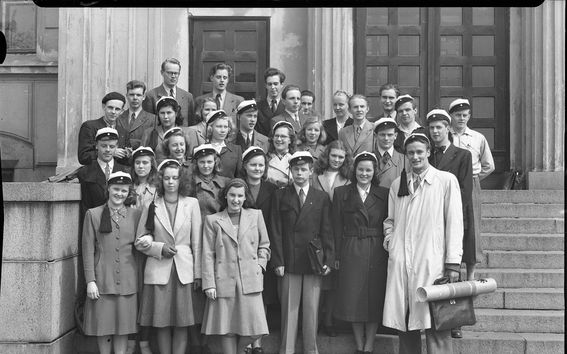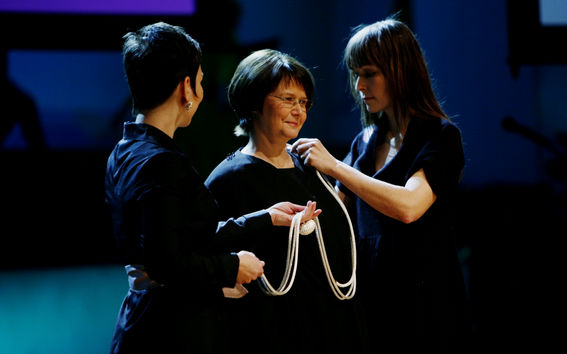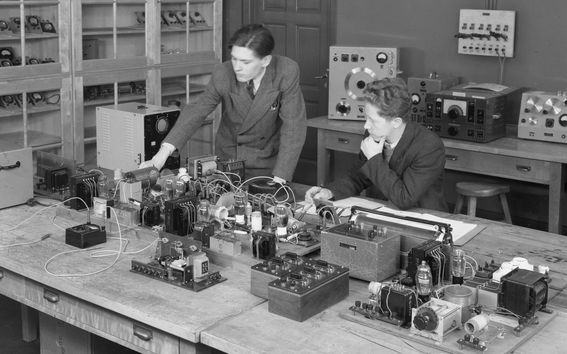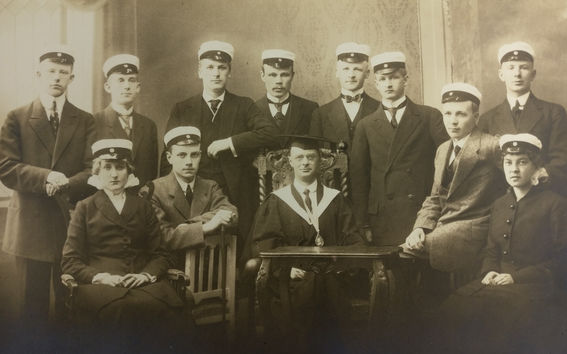History

Today, Aalto University consists of six schools with 12 000 students (FTE), and 4 000 members of faculty and staff, of which nearly 400 are professors.

Aalto University was established as a priority project in the Finnish university renewal. The idea was to create a new innovative university merging science and technology, design and art, and business and economics.
The idea of a merger was first presented in autumn 2005 by the then rector of the University of Art and Design, Yrjö Sotamaa, in his opening speech for the academic year. A more concrete plan for the establishment of a new university was presented in February 2007, in the memorandum of the working group led by Secretary of State Raimo Sailas. The preparations for the university began later the same spring, when Prime Minister Matti Vanhanen included the new university into the Finnish government programme.
Altogether 500 members of the universities that were to form Aalto University were involved in the preparations. A total of 1 600 entries were received for the name competition organised in spring 2008. The name Aalto-yliopisto (Aalto University in English and Aalto-universitetet in Swedish) was confirmed on 9 May 2008.
The Aalto University charter was signed in June 2008. On 19 December 2008, the University's Board selected Professor Tuula Teeri as the first President of Aalto University.
On 1 January 2010, the Helsinki School of Economics, Helsinki University of Technology and the University of Art and Design Helsinki merged and Aalto University started operating.
History of three esteemed universities in the background
The School of Arts, Design and Architecture was founded in 1871 as Craft School. It has grown into one of the most international schools in Finland. It is the largest in its field in the Nordic countries and one of the most respected in the world.
The Aalto University School of Business was established in 1911. It is the first business school in the Nordic countries to have received the Triple Crown, i.e. all three labels of excellence from the world’s leading business school accreditation bodies: AACSB, AMBA, and EQUIS.
Helsinki University of Technology was founded in 1849. The four schools of technology at Aalto University have a leading position in Finland and are internationally renowned.

Alvar Aalto buildings in Otaniemi
The core of the Aalto University Otaniemi campus is a park campus more than 50 years old, which urban plan was the work of Alvar Aalto, and which contains individual buildings designed by him and other Finnish architects such as Reima and Raili Pietilä and Heikki and Kaija Sirén.
Game Changers
The Aalto timeline tells a story visualising and describing Game Changers, which can be events and innovations, derived from Aalto University and its predecessors. Or people, who have had a great impact on Aalto and the Finnish society.

Four schools of technology
The Polytechnic Institute was made a university-level school and renamed the Technological University of Finland in 1908. The school began moving its activities to Otaniemi in 1955.
Aalto University School of Science and Technology was divided into four new schools of technology as of 1 January 2011. The new schools were formed of the former university faculties of TKK.
School of Chemical Engineering (chem.aalto.fi) is based on the Faculty of Chemistry and Materials Sciences.
School of Electrical Engineering(elec.aalto.fi) is based on the Faculty of Electronics, Communications and Automation.
School of Engineering (eng.aalto.fi) is based on the Faculty of Engineering and Architecture.
School of Science (sci.aalto.fi) is based on the Faculty of Information and Natural Sciences.
Teaching and research at the Helsinki University of Tecnology since 1849
Engineering education began in Finland in the first half of the 19th century as part of Government measures to modernise the economy of this small grand duchy on the northern periphery of Europe. Teaching began at the Technical School of Helsinki on 15 January 1849, in the house of master upholsterer Litonius' in the very centre of town.
The first director of the Technical School of Helsinki was the chemist Anders Olivier Saelan, a recent graduate of the University of Helsinki. The school's curriculum was designed to compete with the training system of the trade guilds so that students who completed the entire course received both a general education and training for technical occupations. Actual technical vocational training began in Helsinki after a legislative reform in 1858. The technical trade departments of engineering, mechanical engineering, architecture, chemical technology and surveying were founded at the same time.
The Finnish general basic education system was created after the 1860s on the basis of the system used in Switzerland. As the Finnish system evolved, opportunity arose to give mathematics and natural sciences and technical vocational subjects greater emphasis in the curriculum of the Technical School.
Alongside the University
In 1872, the school was renamed the Polytechnic School and in 1879 the Polytechnic Institute. In conjunction with the latter change, preparatory courses were discontinued and the Institute concentrated on offering the highest technical training.
In 1877, the Polytechnic School moved to its own premises when the building designed by F.A. Sjöström was completed next to Hietalahti Market. Since then, the complex of buildings has been expanded on several occasions. A new, up-to-date chemistry laboratory was completed in 1899. The main extensions of the main building were completed in 1904 and at the end of the 1920s, when the building acquired its present appearance.
In the early 1920s, a storey was added to the chemistry laboratory. During the 1920s, new technical laboratories were built in the neighbouring blocks. When the building of the Technical Research Centre of Finland was completed in 1942, the University of Technology had taken over an entire district of the city.
Enrolment and degrees
By the beginning of the 20th century, the Polytechnic Institute had a little over 200 students. After a legislative reform in 1904 and with a new, larger main building capable of accommodating more students, the number grew to over 400. After the First World War severed Finland's close links with Germany, the number of students grew to almost 600 and the number of new students had to be restricted.
The Polytechnic Institute was made a university-level school on 2 April 1908 and renamed the Technological University of Finland. The change in name brought its students the rights of university students, and its permanent teachers became professors, the degree requirements of doctor of technology were defined and the school-like system was replaced by restricted study rights. In the late 19th century, students who had passed every course received a diploma, as was the custom in German-speaking countries. Likewise, those receiving a doctorate from a university-level institution received a doctoral diploma.
The first degree at the university was either one of an engineer, surveyor or architect. In the 1930s, the separate surveyor's degree was abandoned, while the title 'diploma-architect' was used for a decade. The title 'diploma engineer', which corresponds to a M.Sc. degree, was adopted in the early 1940s in conjunction of a syllabus reform at the same time as the lower technical degrees were defined.
The first doctorate was awarded at the University of Technology in 1912. By the time the first conferment of degrees was arranged in 1934, the University had awarded 11 doctorates. The one hundredth dissertation was completed in 1961. In 2004, Helsinki University of Technology produced some 1800 doctorates, and it has granted 127 honorary doctorates.
Move to Espoo
Moving the University of Technology from the city centre to a more spacious area in the outskirts of the city or, for example, to Tampere was already discussed in the 1910s. Various plans were made for moving to northern Helsinki to districts that were at the time largely undeveloped, including Meilahti and Haaga. As the city grew in the early 1940s, areas even further from the centre, such as Lauttasaari and Puotinharju, were discussed. However, in 1945 an architectural competition was held to expand the operations of the University in Hietalahti.
The rapid advance of technical sciences after the Second World War changed plans for good. To keep in step with post-war progress, the University and the Technical Research Centre of Finland needed substantial amounts of land to build laboratories. The city blocks available were much too small. The final decision to move the University out of the city was made in 1948. The State bought the lands of Otaniemi Manor in the eastern part of the rural municipality of Espoo to serve as the campus of the University and the Technical Research Centre on 15 January 1949. The area was being farmed at the time and the plan was to incorporate it into the City of Helsinki, but instead the area remained part of Espoo and the University is today located in the City of Espoo.
Development began in Otaniemi with housing for students, called Teekkarikylä or student village. Its first residents were not students, however, but athletes taking part in 1952 Helsinki Summer Olympics. The first functions of the University moved to Espoo in 1955. The main part of the main building was completed in 1964 and the move from Hietalahti was finalised ten years later. At the same time the main building was completed, work on the student union building Dipoli was finished. In the 1970s, Dipoli became the best-known venue for congresses and training courses in Finland.
In the 1950s and '60s, Otaniemi became one of the most interesting sites of Finnish architecture. The general plan of the campus was made by the architect Alvar Aalto. His office was in charge of the main building and the Otahalli sports hall, built for the Olympics, and of several other buildings. The oldest dormitories, the Servin Mökki restaurant and the Otaniemi chapel were designed by the office of Heikki and Kaija Siren. Dipoli was designed by Reima Pietilä and Raili Paatelainen.
The Teekkarikylä and the University of Technology were built in the woods in the rural municipality of Espoo. Espoo gained the town status in 1972 and it has since grown to become Finland's second largest city. The campus of the University has expanded to include business incubators and a technology park. The campus has become one of Espoo's best known districts.
Panu Nykänen

School of Arts, Design and Architecture
The School of Arts, Design and Architecture, founded in 1871 as the Craft School, is one of Finland’s most internationally known schools. It is the largest in its field in the Nordic countries and one of the most respected in the world. The school became a part of Aalto University in 2010, and started operating in its present form in 2012.
Campus from Ateneum to Arabianranta
Atski, an early nickname for the school, originated from Ateneum, the first location of the school in the noble building drawn by Architect Theodor Höijer (1843-1910), which is located by the Railway Square in Helsinki. Ateneum served as the furnace of industrial art education for 100 years.Now the building is home to the Ateneum Art Museum and the Central Art Archives, both of which are part of the Finnish National Gallery.
The School of Arts, Design and Architecture moved to a location within the Arabia factory complex in 1986. The area is known as the Arabianranta district, which over the years has grown into an internationally significant industrial art and media centre as the result of an art and design city project created around the school.
Studies and research
Since the 1970s, the aim of education at the School of Art and Design has been to deepen students’ scientific and artistic competence, and to refine their innovative processing into professional practices. The original, traditional education in product and environmental design was gradually supplemented by strong training in visual communication, new media, film, and television.
The school's swift internationalisation has opened doors to partnerships with foreign institutions and businesses, and to international markets such as China and Japan. Media education, research and development, as well as multidisciplinary research schools are now integrated in the operation of the school.
Since the 1990s, the establishment of multidisciplinary study programmes between different universities has been part of the renewal and expansion of education in Finland. For the school, joint degree programmes and/or partnerships like International Design Business Management (IDBM), Polis, Master of European Design (MEDes), Helsinki School of Creative Entrepreneurship (HSCE), and Visual Journalism have paved the way for other, more extensive cooperation among various universities
The degree system renewed in 1994 divided the basic degree into a lower and higher basic degree: a three-year degree of Bachelor of Art (BA), and a two-year degree of Master of Art (MA). Until the end of 1999, it was possible to get a Licentiate of Art degree.

Helsinki School of Economics
The School of Business already had a strong heritage stretching back almost 100 years when Aalto University was established in 2010.
The School of Economics was founded in 1911. It was located on Fabianinkatu in central Helsinki.
In order to graduate, students were required to complete at least four terms of studies at the university. Studies included lectures, seminar exercises, laboratory work, and discussion evenings. At the time it was established, the School of Economics had a total of 117 students, of which 42 were actual students and 75 people who sat in on lectures. The School’s curriculum was designed for two years of studies.
Students could complete a degree in one of two departments: Business and Industry or Business and Banking. Compulsory subjects, for students of both departments, included general economics, statistics, business and business practice, business geography, or business history, legal science, general accounting, and a model office, as well as chemistry and goods and commodities. In the early years, attendance at lectures was compulsory and necessary as there were only a few copies of books on business available.
Establishment of degree programmes
The programme for a Bachelor’s degree in Economics was established on 15 December 1920. The programme was an extension of studies after college graduation and required completion of at least four subjects in a specified subject area. Only few graduates chose to continue their studies due to the substantial amount of independent study required. Thus, the completion of a Bachelor's degree was quite arduous.
As the number of graduates from the School of Economics grew, the Finnish title 'ekonomi' (economist/economic) was adopted in 1928. The title was voted on in a referendum. The title Master of Sciences (Economics) was adopted at the beginning of 1995.
The Doctorate programme for Economics was established in 1931 and on 27 October 1937 Vilho Paavo Nurmilahti became the first person in Finland, and the Nordic countries, to receive a PhD. The first Licentiate of Economics graduated from the School of Economics on 26 November 1949.
In 1945, the School of Economics was granted the right to hold formal ceremonies to confer degrees. The first such ceremony was held in 1946 and since then, the School has held a ceremony once every five years.
Campus
In 1950, once construction of the main building, designed by Hugo Harmia and Woldemar Baeckman, had been completed, the School of Economics moved into its present premises on Runeberginkatu in central Helsinki. The main building is an impressive example of architecture from Finland’s post-war rebuilding era. The construction of the main building was funded for the most part through donations of alumni and support from the business world. The main building went through a major renovation which was completed in the autumn of 1998.
In 1969, the School purchased a former girls' school, located next to the main building, which today is called Chydenia. The building was completed in 1923 and it was designed by architect Onni Tarjanne.
After nationalisation
After the nationalisation of the university in 1974, it was renamed the Helsinki School of Economics. At the time, nationalising the university evoked debate: on one hand, nationalisation ensured funding for institutions of higher learning, on the other some feared it would be an end to the tradition of autonomous institutions of higher learning.
As a result of nationalising the university, its administration had to be reorganised, which many believed would damage the traditional and important relationships that schools of economics had developed with the business world.
In the case of the Helsinki School of Economics, this issue was resolved by transferring some of the wealth from the formerly private university to the Helsinki School of Economics Foundation (HSE). The HSE Foundation still operates today.
One positive outcome of nationalisation was that it finally ensured legislation specifically for institutions of higher learning. The Helsinki School of Economics was the first to receive its own legislation, which came into effect on 1 August 1974.
Aalto University formed
The School of Economics went through its last makeover in 2010 when it merged with the University of Art and Design Helsinki and the Helsinki University of Technology to form the multidisciplinary Aalto University.
The change meant that the School of Economics was no longer a separate university focused on economics and business, but a part of a larger, multidisciplinary university. It was also no longer a state-owned accounting office but an independent foundation. Co-operation between economics, technology, and art is being fostered in order to create a world-class standard. New international career systems, learning environments, forms of co-operation with businesses and operations culture are helping Aalto move toward this objective.
Another important goal is to become an internationally recognised school. With this in mind, the English name of the School was changed from the School of Economics to the Aalto University School of Business on 1 August 2012 to better highlight the School's broad operations in all fields of business, as well as give the School of Business a name that was similar in form to most world-class schools in this field.






